ON THE TOWN with Chip Deffaa …. for July 5th, 2016
I’ve always liked Andrew Keenan-Bolger's work. He was a memorable child actor, playing leads on Broadway in shows like "Beauty and the Beast" and "Seussical," when he was around 13 or 14 years old. I admired his sunny, open-hearted work then. And he's even more successful today (at age 31) as an adult--not every child actor can make such a transition. He conveys the same sort of buoyant spirit on stage now as he did when I first saw him in those shows he did so well as a youth.. (His whole family is talented. He and his sisters, Celia Keenan-Bolger and Maggie Keenan-Bolger, are all making their contributions to the arts.)
[avatar user=”Chip Deffaa” size=”96″ align=”left” ] Chip Deffaa, Editor-At-Large[/avatar]
Tonight I’ll be flying to Korea, once again, to direct a production of my show “George M. Cohan Tonight!” We’ve done this show in many cities, in the U.S. and abroad. And this playwright/director is very much looking forward to taking it back to Seoul. It’ll be fun.
But while I’ve got a bit of free time today, before I go overseas, I want to look back at the 2015-2016 theatrical season, and offer comments on a few productions I especially enjoyed that, for one reason or another, I haven’t had a chance to comment on before. And offer a few general reflections.
First, this season reminded me strongly that the best dramatic productions are just as likely to be found in a small theater in New York, off-Broadway, as they are to be found on Broadway.
My own two personal favorites, among the serious dramatic productions I caught this past season, were both mounted in small venues.
* * *
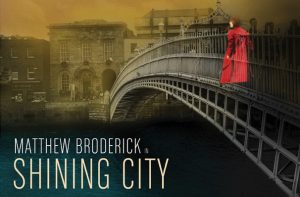
Shining City poster
Broderick was in first-rate form. Earlier this past season, he starred in “Sylvia,” which was my favorite comedy of the season; and in “Sylvia” and “Shining City” he gave two of the best performances of his career. There is a gentle, burnished glow to his performances these days that I find immensely appealing. I’ve always enjoyed his work, from the very start of his career, but he is capable of more now. He can perform with such ease and grace and naturalness on stage, it is easy to under-estimate what he’s doing. It does not feel like “acting”; we are simply observing someone living. And yet, in his own quiet, unaffected way, he commands our attention. He’s got great presence, and we miss him, in the scenes when he is absent from the stage.

Matthew Broderick
In “Shining City,” Broderick portrays a character identified simply as “John”–a somewhat bumbling, unassuming fellow, whose wife has recently died. He’s been seeing visions of the dead wife. He is amiable, slightly befuddled, and altogether human. We feel for him. And, emotionally, he’s somehow stuck in place. He needs to get on with his life, start a new chapter, but is unable to do so. He has come to a therapist for help. And we watch the therapist (portrayed convincingly by Billy Carter) work at getting to know him, trying to figure out how he can be of help. What Broderick’s character does not realize–there is no reason for him to know it–is that the therapist is somewhat similarly stuck in place in his own life; an important relationship has recently ended for him, too; and the therapist needs to find a way to get on with his life, make a fresh start. Both the therapist and the client need to get unstuck.

Matthew Broderick and Billy Carter in Shining City
I cannot say more without spoiling some of the surprises in this very well-crafted play. But the play got to me; it affected me. I didn’t just enjoy it (which would be reason enough to recommend it); I felt changed by it. And Broderick–beautifully underplaying the role, always keeping something in reserve–seemed so down-to-earth, so vulnerable, so accessible, such a “regular Joe,” such a perfect “Everyman,” we could all relate to him. I’m very glad I got to share in that play.
* * *
I’m glad I was able to catch the revival–far from Broadway, down in Greenwich Village–of Tennessee Williams’s drama “Orpheus Descending,” directed by Austin Pendleton. (He understands well this play, which he directed for the first time fully 45 years ago. And Olympia Dukakis, who starred in that production, came to see this new production.)

Irene Glezos in Orpheus Descending
It’s powerful theater. Williams was fearless. Time and again in his plays–even his lesser plays– he tackled the biggest themes; the strongest human needs, desires, passions. And the large cast–paced by Irene Glezos, Todd d’Amour, Beth Bartley, Mia Dillon, Michelle Tauber, and Keir Dullea (giving a harrowingly intense performance)–did justice to the work. The leads were all strong. Not every minor role was perfectly cast. (The sheriff, for example, had the right look, but he didn’t project the sense of menace the script required; he needed more backbone.) But the key players brought vividly to life this tale of love and lust, and desperation in a sleepy Southern town.

Beth Bartley in Orpheus Descending
The play rambles somewhat–in that sprawling, unruly way that plays of Williams sometimes do. It’s a bit messy, the way life itself often is. And it takes time to gather its forces. But it never fails to live. The characters are richly drawn. (Even minor characters feel like real people in Williams’s plays.) And in the end, the play packs a terrific emotional wallop. I’ve always liked this play, and the actors (with few exceptions) were very well cast. The Greeks understood the power that theater could have. And so did Williams.
This may not be Williams at his very best, but it was still more powerful than most of what passes for theater today. This was one of my favorite dramatic productions of recent years. I’m very glad this limited engagement was mounted.
If I had to name one “Good Broadway Musical that Almost No One Got to See this Season,” it would be the short-lived “Tuck Everlasting.”
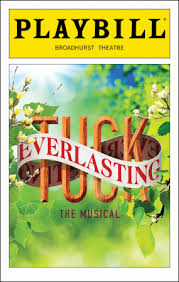
Tuck Everlasting Playbill
“Tuck Everlasting” may not have been a perfect musical–very few are–but it certainly was a lovely one. And a genuinely moving one. It contained moments of real magic. It was unlike anything else offered this past season on Broadway, and I was very sorry that it closed so very quickly–just 39 regular performances. At least they got to make a cast album. It was such good theater, I want to take a bit of time to discuss it. It deserves the attention.

Andrew Keenan-Bolger
I’m happy that Keenan-Bolger finally got to create a starring role on Broadway that fully allowed him to show what he’s capable of. He was wonderful in the featured role of “Crutchie” in “Newsies”–and that musical suffered a noticeable loss when he left it–but this was a bigger, more important role. And in this show–unlike “Newsies”–he got to dance a bit, too. Actors don’t often get roles that seem so perfectly tailored to their particular strengths.
I’ve always liked his work. He was a memorable child actor, playing leads on Broadway in shows like “Beauty and the Beast” and “Seussical,” when he was around 13 or 14 years old. I admired his sunny, open-hearted work then. And he’s even more successful today (at age 31) as an adult–not every child actor can make such a transition. He conveys the same sort of buoyant spirit on stage now as he did when I first saw him in those shows he did so well as a youth.. (His whole family is talented. He and his sisters, Celia Keenan-Bolger and Maggie Keenan-Bolger, are all making their contributions to the arts.)

Terrence Mann in Tuck Everlasting
And director/choreographer Casey Nicholaw found an 11-year-old girl named Sarah Charles Lewis whose singing and acting was earnest, winning, and right “on the money.” She really is a find. The character that Keenan-Bolger played became, in the show, her first crush. Their scenes together rang true. By the way, Casey Nicholaw has certainly been on a roll in recent years as a director/choreographer, helping give us such Broadway shows as : “The Book of Mormon,” “Aladdin,” “Something Rotten,” and “Tuck Everlasting.”

Andrew Keenan-Bolger in Tuck Everlasting
The show boasted a pleasing score by Chris Miller (music) and Nathan Tysen (lyrics). The script was by Claudia Shear and Tim Federle. (I could hear Federle’s good voice, as a writer, in some of the funny, surprising, and very human lines of dialogue. And it’s certainly been clear from books he’s written that he understands young people particularly well.)
I loved the original novel that this show is based upon. (I would have liked to have worked on this show, if only because the novel touched me so deeply.) This show captured well–moreso than the film adaptation that Disney made–the spirit of the original book. (Disney, I should note, was not involved in this production, which is based on the original novel, not the Disney film.)
There were some flaws in this production. The opening–a little too brash for my tastes–wisn’t quite right. For my own tastes, I found the opening a bit off-putting. A quieter, gentler, simpler opening would have worked better for me, to draw me into such a gentle fairy tale. But once I got over the bumps at the very start of the show, the musical seemed to find its own voice and its own pace, and I was beguiled.
I winced at one or two obvious lines in the script. You really don’t need to have a character come right out and utter these words: “Don’t be afraid of death….Be afraid of not being truly alive. You don’t need to live forever, you just need to live.” The whole show was already imparting that very message to us brilliantly; that was, in fact, the real essence–the whole point–of the show. I didn’t need to have a character verbalize it. It didn’t need to be spelled out; the message was conveyed to us so wonderfully and thoroughly via lyrics, music, dance, characterizations, and storyline. The show itself was a kind of extended meditation on mortality, and the importance of living fully.
But the flaws I’m mentioning were really small potatoes in an evening offering so many delights. And so much substance.
“Tuck Everlasting” struck me as a show the whole family could appreciate, with more depth and wisdom, and intelligence than most Broadway shows marketed as family shows. The typical Disney musical–“Beauty and the Beast,” “Tarzan,” “Aladdin,” “The Little Mermaid”–is well-crafted, but really written for younger people. Adults can enjoy those shows too, of course–I did–but there’s always a sense that the writing is primarily geared for young people. But “Tuck Everlasting” was a fine show for anyone. It didn’t have the “dumbed down” feel so many supposed “family shows” tend to have. I welcomed that.
They show took a long time to get to Broadway. For a while–after the first planned production was indefinitely postponed–it looked like it might not get here at all. I’m glad it finally made it. It was good while it lasted. I just wished it could have lasted longer. It worries me a little that a show this fresh and imaginative and well crafted could not succeed commercially. It worries me that “Bright Star”–my own personal favorite among musicals I saw in the past year–did not last too long (109 regular performances). And “Shuffle Along” will be gone in just a few weeks. While many far less creative works run on and on…..
* * *

West Side Story Playbill
The show, six decades after its creation, remains bigger, bolder, more ambitious than almost anything else out there. And this production (with a cast of 35)–directed by Mark S. Hoebee, and with choreography reproduced by Alex Sanchez–was often immensely satisfying.
It was certainly well sung. (And what a joy it is to hear those glorious songs.) The orchestra did justice to Bernstein’s masterly score. It was, for the most part, very well danced. There were moments, in the dancing, that still seemed under-rehearsed, as of the official opening night, which I attended. (But this is a very big and demanding musical to pull off; ideally, it should have more rehearsal time than many musicals require.)
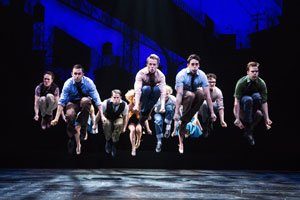
west side story
I was not fully satisfied with the casting and acting; I did not always believe that these characters were from the streets, were members of a gang; sometimes they simply seemed like very nice singers and dancers from a conservatory; they ideally should have more of an edge; we should be able to believe they are gang members capable of violence; sometimes they simply seemed like nice, genteel, singers and dancers.
But even with these flaws, these imperfections, the show still packs a tremendous emotional wallop. And even if this production was not perfectly cast, it was still a largely satisfying revival of one of the major works in the canon. And we are not likely to see abetter revevival of this show in the region any time soon. I give Hoebee and Paper Mill credit for tackling this huge, demanding–and highly rewarding show. It may not have been a perfect revival of “West Side Story,” but it was still a memorable night of theater.
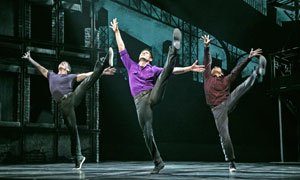
West-side-story
Incidentally, Paper Mill Playhouse–the State Theater of New Jersey– received a special Tony Award this year, for being an outstanding regional theater. It’s well-deserved, and long overdue.. Such engaging Broadway musicals of recent years as “Newsies” and “Honeymoon in Vegas” were launched at Paper Mill. Their best new musical of the past year, “A Bronx Tale,” will be going to Broadway. The theater has maintained a terrific track record for decades. (I’ve been seeing shows there since the 1970s.) Some of their memorable productions, from “Follies,” to “Show Boat,” to “Children of Eden,” have been recorded or televised. (One Paper Mill production that should have gone on to Broadway, or been recorded or televised, was their production of “Gypsy,” starring Betty Buckley, directed by Mark Waldrop; that was one of the best productions of any show I’ve seen at Paper Mill; and Buckley was a top-drawer “Momma Rose”–my personal favorite of all I’ve seen.) And I’ve watched Paper Mill help nurture many promising young (and then-unknown) performers, who went on to success on Broadway and beyond–from Rob McClure, to Nick Jonas, to Laura Benanti, to John Lloyd Young, to Anne Hathaway….. Big congrats to all of the good folk who run Paper Mill: Mark Hoebee, Todd Schmidt, Patrick Parker, Shayne Austin Miller, John Zeitun, et. al. Everyone at Paper Mill has much to celebrate
* * *.
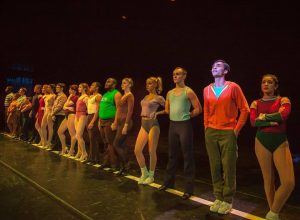
I’ve seen this iconic show many times, but still I found myself choking up near the end. Properly done–and this production was properly done–“A Chorus Line” remains powerful theater. I took particular note of several performers–none of whom I’d ever seen before–who really did justice to their characters. Jake Vielbig was, by turns, tender and awkward, graceful and strong, as Paul San Marco, one of the hardest roles to carry off. He was just wonderful; compelling. He sure has a future, if he chooses to pursue a career in show business.

Emily Louise Franklin was a perfect “Val” (the sassy “Dance 10/Looks 3” character), and commanded attention with her dancing before she even said her first words. . Jacob Roberts-Miller was everything a “Bobby” should be.( He reminded me very much of my late friend Thommie Walsh, who originated the role–which was based on him–on Broadway.) I appreciated the contributions made by vivacious Gabi Campo (“Diana Morales), pure-voiced Nia Colemon (the first African-American “Maggie”), Cassidy Stoner (“Sheila”) Emily Neis (“Cassie”), Adam H. Levy (“Zach”), et. al . It’s a challenging ensemble show, and they made it work. I’m very grateful I got to see this night. (An added treat for me was running into actor/director friend Andrew Higgs; that put an extra shine on an already good night.)
It’s always interesting to see good college productions. And Pace gives its students a Broadway-sized stage to work on. (I’ve directed on that stage.) I hope those kids realize how lucky they are to have done “A Chorus Line” with Baayork Lee, who works from the actual production script, with all of the markings from the original run; they’re learning from a key member of the original group that created the show.

A Chorus Line
I wish all of those kids well. And some of them – if they pursue it, and stick with it, and have the courage to take good offers when they come–should have careers in the theater. (Of course, not everyone with potential will stay in the arts; it takes a tremendous amount of guts to pursue a career in the arts, and the rate of attrition is high. But I wanted to put out there, via this column, the names of a few students who impressed me: Vielbig, Franklin, RobertsMiller….. I always like sharing names of rising young artists-to-watch. Just as I like it when others I respect tell me of up-and-coming “unknowns” worth keeping an eye on.
I still remember when Carol Channing told me there was a Juilliard student blessed with the kind of voice “that comes along only once in a generation”–and she urged me to remember the name of young Audra McDonald. And of course Audra McDonald went on to star in assorted Broadway shows, and win assorted Tony Awards. Carol Channing–from whom I’ve learned more than from anyone else in the business–has always had a very good eye for spotting talent.
And I like calling attention to artists-to-watch.
* * *

Nutmeg Ballet Co
But then I saw him carry off with panache the leading role (“Espada”) in the first act of “Don Quixote,” a famed 19th century ballet by choreographer Marius Petipa and composer Marius Pinkus (staged here by Nutmeg’s Ballet Master, Alexi Tchernichov). And he was breathtaking in this classic ballet. This calls for a completely different kind of dancing than we saw in “Beloved,” and he pulled it off brilliantly.
He was commanding, from beginning to end. It is a bravura role, and not everyone has it in them to pull off such a role. (I’ve directed actors in some musicals where I’ve had to explain that they’ll be playing a character who has to own every bit of the stage when he walks on, and carry the stage with him when he exits; if the actor is not capable of doing that–and most are not–you simply can’t teach it.) Kundzins claimed that demanding role as his own, and every gesture–even flinging a cape–was right where it should be; precise, yet animated by a welcome suggestion of wildness. There was passion, there was fire, throughout the piece. I just loved it, and wished I could have somehow watched it again.
Sidebar. The first time I saw “Don Quixote,” many years ago, I thought it was a boring ballet. The next time I saw it, by different dancers in a different company, I was mesmerized; I realized it was not a boring ballet at all, I had merely seen boring dancers execute it mechanically the first time; they made correct moves, but without the passion needed to make the characters live.
Kundzins’s choices, on stage, were very bold, very daring. A beautiful balance of wildness and restraint. I love performers who make bold choices, and have the talent to back it up. (Another sidebar. As a playwright/director, I love working with the Dutch actor Joris de Graaf when I can, because he makes such bold, daring choices. Occasionally, in rehearsals, other actors have come to me and asked, “Aren’t you going to rein him in? You don’t know what he’s going to do next!” But it’s a tremendous asset if an actor has a touch of wildness he can draw upon. And dares to take chances.) Kundzins’s performance was galvanizing. The energy of the whole cast was high on stage throughout the piece. (In the same dance program, incidentally, I got to witness Kundzins’s younger sister,Rachel, maker her debut as a featured dancer; and clearly there m must be something in those Kundzin genes, because she made the most of her opportunity, as well.)

Nutmeg Ballet
“Don Quixote” was carried off at a very high level, representing Nutmeg at its best. (And they’ve had a strong group this year.) Kudos, too, to featured dancers Alexsander Keeperman (“Basillio”), Alma Evertz (“Mercedes”), and Jennifer Schwartz (“Kitri”) These are among my favorite Nutmeg dancers and they performed with characteristic professionalism and eclat. (They weren’t featured as heavily in this particular program as they have been in some others I’ve seen; Nutmeg, like most dance companies, gives different artists opportunities to play leading roles at different performances, and in different programs. Had I gone on another day during this run, I would have seen different artists showcased more prominently.)
Incidentally–if I can offer one more sidebar–I was very much aware I was witnessing Jennifer Schwartz’s final performance with Nutmeg; she is moving on to become a trainee with the :Louisville Ballet. I am sorry to see her go, along with several other of Nutmeg’s best ballerinas, including Kelsey Morris, Riley McGregor, and Cassandra Punzo; it will not feel like Nutmeg without them; but moving on is a part of life, and I’ve enjoyed very much their contributions over the years. Nutmeg is losing several of its best female dancers; most of its best male dancers will be staying on. Speaking of dancers moving on… I’d like to offer congrats, while I’m at it, to Matanya Solomon, who’ll be leaving Nutmeg to train with the American Repertory Ballet, which has been a vital force in Princeton, New Jersey, for some six decades. I was glad to see Solomon–who’d been sidelined due to surgery last year–dancing the demanding role of “Romeo” in the “Romeo and Juliet” balcony scene for his final Nutmeg appearance. I admire his dedication, determination, stick-to-it-ive-ness. And you sure need it, if you’re to pursue dancing, because injuries and surgery often seem to go with the territory. It was good to see him back in action, ending his Nutmeg years on a strong note, having a chance to try such an important role
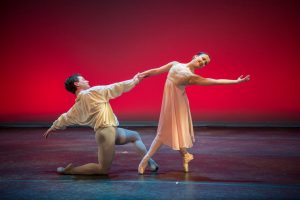
Nutmeg Ballet
But whether you’re given a part that is big or small, it’s up to you to make the most of it. What a kick I got out of Julius Taiber’s work as one of the toreadors in “Don Quixote.” Not a big role by any means, but he projects great confidence, feels like he was born to be on stage, and is always interesting to watch. When he moves up into principal roles in future years, he’s going to be fun; you can already tell. Some performers (like Taiber) clearly love the stage, and it seems to love them back. (Those are the kind of performers I always look for when I’m casting a show of my own.) Others seem a bit scared of it, or appear to be merely going through the motions when they work. But I liked this “Don Quixote” a lot. I wish I could have caught more than one performance.
And I must add a word of praise for choreographer Kate St. Armand and her charges, who were really a delight in “Secrets.Me,” set to infectious music by Raphael Beau. I could have watched that over and over and over. Kate St. Armand understands–as Bob Fosse did–that you can isolate and call attention to a small movement–perhaps something as simple as a shrug, a roll of the shoulders, a come-hither turn of the head, or a finger raised to the lips–and make it impactful. That piece sure worked.
Oh, there’s so much more I want to say, and I wish I could name every single one of the dancers that Sharon Dante, Joan Kunsch, Victoria Mazzerlli, Tim Melady, Susan Szabo, and Cassie Sprance presented on that Nutmeg stage; but we’d be here all day. It always makes me happy to see good dancers doing their thing. I like dance And so many of the best actors I worked with as a playwright and director have come from the world of dance.
* * *
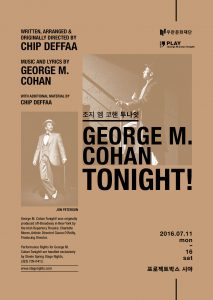

His latest starring role is portraying Irving Berlin on the premiere recording of my show “Irving Berlin: In Person,” which has just been released. The album features more than 30 Berlin songs, with musical direction by Richard Danley, choreography and tap by Rayna Hirt, and a special guest appearance by Hawkins Davis Gardow. Edith O’Hara provided space for development of the show, at the 13th Street Repertory Theater in New York. It’s always fun to get another album out. This is my 15th album, and I’m delighted that Jed Peterson, who made such a strong impact on stage, even at the start of his career, is on it now.

JED PETERSON
It’s always gratifying to me to see people fulfilling the promise they demonstrated so clearly in their youths. Today, for example, Celia Keenan-Bolger is a respected Broadway leading lady, with assorted hit shows, from “Les Miz” to “Peter and the Starcatcher,” to her credit. I can close my eyes and see her singing—and boy! She was terrific, even then—in my own theater festival, 14 years ago, before she landed any work on Broadway.

Max Beer
So when I see promising younger artists today—whose talents are just beginning to bloom—whether they’re dancers like Alexsander Keeperman, Alma Evertz, and Andris Kundzins, or actors like Jake Vielbig, Emily Louise Franklin, and Sarah Charles Lewis–I take their talents seriously. I want to encourage them to follow their dreams because they’re already shining on stage. And I’ll be delighted to see their talents continue to develop.
— CHIP DEFFAA
July 5, 2016






Leave a comment